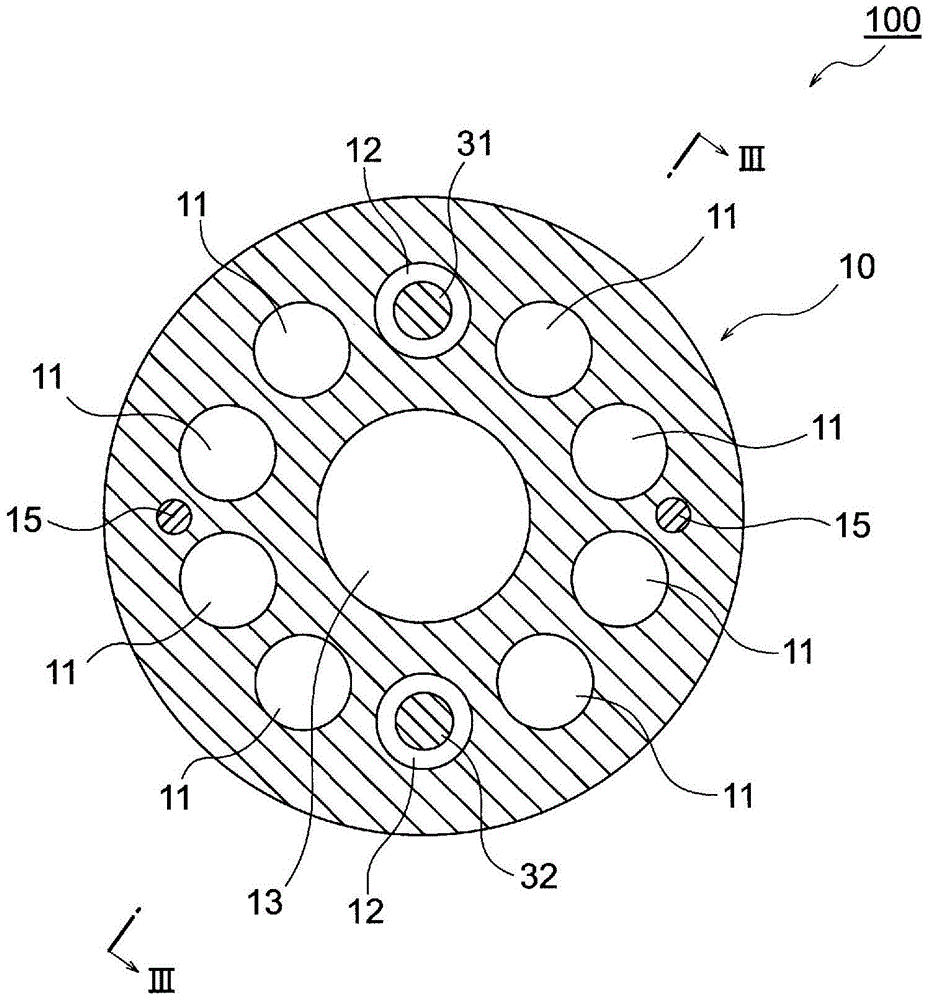electrode probe
A probe and electrode technology, applied in the field of electrode probes, can solve the problems of insufficient prevention of thrombus, poor thrombus formation inhibition effect due to electrode surface cooling effect, and small front-end electrode, and achieve excellent thrombosis inhibition effect and thrombosis inhibition effect. Excellent effect, thrombus formation inhibitory effect
- Summary
- Abstract
- Description
- Claims
- Application Information
AI Technical Summary
Problems solved by technology
Method used
Image
Examples
no. 1 Embodiment approach
[0047] Hereinafter, one embodiment of the electrode probe of the present invention will be described with reference to the drawings.
[0048] Figure 1 to Figure 4 The electrode probe shown is an ablation probe used in the treatment of cardiac arrhythmias.
[0049] The ablation probe 100 of the present embodiment includes: a probe post 10 having a central lumen 13 through which a guide wire or the like passes, and 10 sub-lumens arranged around it at equiangular intervals (36° intervals) (as liquid 8 inner cavities 11 of the flow path, and 2 inner cavities 12 as the insertion passages of the pull wires 31, 32); the front end electrode 20, which is connected to the front end side of the probe column 10 and has a spherical part 21; the ring shape Electrode 40, it is installed on the front end portion of probe column 10; Control handle 70, it is connected with the rear end side of probe column 10; Liquid injection pipe 80; And temperature sensor (thermoelectric pair) 90, it is in...
no. 2 Embodiment approach >
[0118] Figure 5 The ablation probe 105 shown has a probe post 50 having 10 sub-lumens (eight lumens 51 serving as liquid flow channels, and two lumens serving as insertion passages for pulling wires). It has a tapered front-end diameter reduction portion 50A that is tapered toward the front-end direction, and eight flushing openings 512 for flushing liquid to the surface of the front-end electrode 20 are arranged on the front-end diameter reduction portion 50A, and the front end of the probe column 50 is narrowed. Eight inclined lumens 511 are formed inside the diameter portion 50A. The eight inclined lumens 511 communicate with each of the eight inner cavities 51 (non-inclined lumens) on the rear end side, and the sides face the radially outer side of the probe column 10. The inclined side extends toward the front end and reaches each of the flushing openings 512 .
[0119] In addition, in Figure 5 in, with Figure 4 Like components of the ablation probe 100 shown are gi...
Embodiment 1
[0133] for having image 3 as well as Figure 4 As shown in the cross-sectional configuration, the outer diameter of the probe post 10 (D 1 ) is 2.4mm, the above distance (L 1 ) is 2.63mm, the inclination angle (β) of the front-end reduced diameter portion 10A is 10.0°, the above-mentioned distance (L 2 ) is 1.21mm, the inclination angle (α) of the inclined lumen 111 is 5.0°, and the diameter (D 2 =D 1 +2(L 2 ·tanα-L 1 tanβ) is 1.68mm, (D 2 / D 1 ) of the ablation probe 100 with a value of 0.70 was compared with that of the ablation probe 100 using the analysis software "SoLiDWorks FLow SimuLATioN" (manufactured by DAssAuLTSysTEms SoLiDWorks CorPorATioN) in a state where the distal end part was immersed in blood and flushed with physiological saline. The presence of physiological saline in the liquid (blood and / or physiological saline) in contact with the distal end hemispherical surface 21A of the distal end electrode 20 is simulated.
[0134]As a result, the ratio of...
PUM
 Login to View More
Login to View More Abstract
Description
Claims
Application Information
 Login to View More
Login to View More - R&D
- Intellectual Property
- Life Sciences
- Materials
- Tech Scout
- Unparalleled Data Quality
- Higher Quality Content
- 60% Fewer Hallucinations
Browse by: Latest US Patents, China's latest patents, Technical Efficacy Thesaurus, Application Domain, Technology Topic, Popular Technical Reports.
© 2025 PatSnap. All rights reserved.Legal|Privacy policy|Modern Slavery Act Transparency Statement|Sitemap|About US| Contact US: help@patsnap.com



